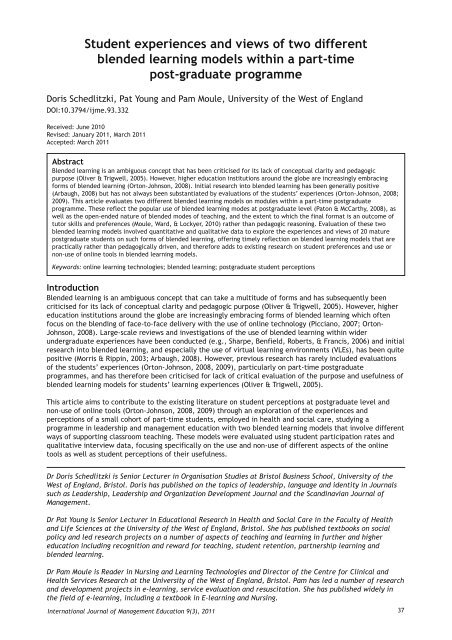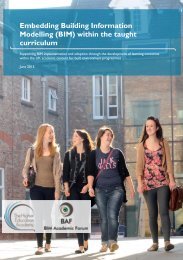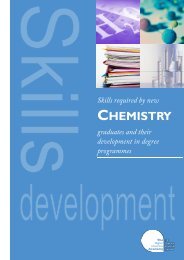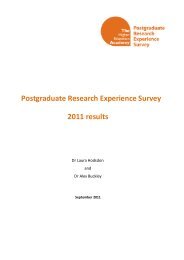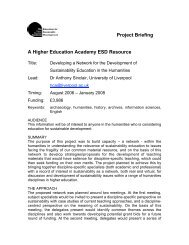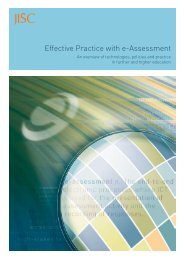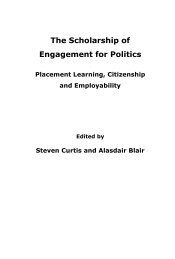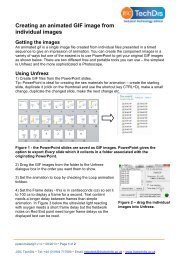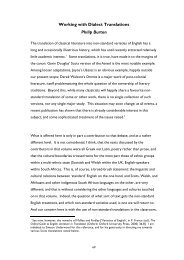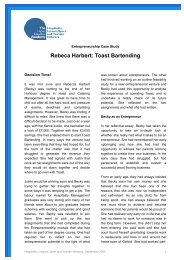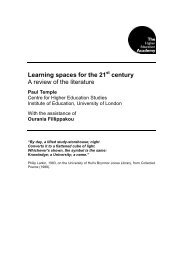IJME9no3:Layout 1.qxd - Higher Education Academy
IJME9no3:Layout 1.qxd - Higher Education Academy
IJME9no3:Layout 1.qxd - Higher Education Academy
Create successful ePaper yourself
Turn your PDF publications into a flip-book with our unique Google optimized e-Paper software.
Student experiences and views of two different<br />
blended learning models within a part-time<br />
post-graduate programme<br />
Doris Schedlitzki, Pat Young and Pam Moule, University of the West of England<br />
DOI:10.3794/ijme.93.332<br />
Received: June 2010<br />
Revised: January 2011, March 2011<br />
Accepted: March 2011<br />
Abstract<br />
Blended learning is an ambiguous concept that has been criticised for its lack of conceptual clarity and pedagogic<br />
purpose (Oliver & Trigwell, 2005). However, higher education institutions around the globe are increasingly embracing<br />
forms of blended learning (Orton-Johnson, 2008). Initial research into blended learning has been generally positive<br />
(Arbaugh, 2008) but has not always been substantiated by evaluations of the students’ experiences (Orton-Johnson, 2008;<br />
2009). This article evaluates two different blended learning models on modules within a part-time postgraduate<br />
programme. These reflect the popular use of blended learning modes at postgraduate level (Paton & McCarthy, 2008), as<br />
well as the open-ended nature of blended modes of teaching, and the extent to which the final format is an outcome of<br />
tutor skills and preferences (Moule, Ward, & Lockyer, 2010) rather than pedagogic reasoning. Evaluation of these two<br />
blended learning models involved quantitative and qualitative data to explore the experiences and views of 20 mature<br />
postgraduate students on such forms of blended learning, offering timely reflection on blended learning models that are<br />
practically rather than pedagogically driven, and therefore adds to existing research on student preferences and use or<br />
non-use of online tools in blended learning models.<br />
Keywords: online learning technologies; blended learning; postgraduate student perceptions<br />
Introduction<br />
Blended learning is an ambiguous concept that can take a multitude of forms and has subsequently been<br />
criticised for its lack of conceptual clarity and pedagogic purpose (Oliver & Trigwell, 2005). However, higher<br />
education institutions around the globe are increasingly embracing forms of blended learning which often<br />
focus on the blending of face-to-face delivery with the use of online technology (Picciano, 2007; Orton-<br />
Johnson, 2008). Large-scale reviews and investigations of the use of blended learning within wider<br />
undergraduate experiences have been conducted (e.g., Sharpe, Benfield, Roberts, & Francis, 2006) and initial<br />
research into blended learning, and especially the use of virtual learning environments (VLEs), has been quite<br />
positive (Morris & Rippin, 2003; Arbaugh, 2008). However, previous research has rarely included evaluations<br />
of the students’ experiences (Orton-Johnson, 2008, 2009), particularly on part-time postgraduate<br />
programmes, and has therefore been criticised for lack of critical evaluation of the purpose and usefulness of<br />
blended learning models for students’ learning experiences (Oliver & Trigwell, 2005).<br />
This article aims to contribute to the existing literature on student perceptions at postgraduate level and<br />
non-use of online tools (Orton-Johnson, 2008, 2009) through an exploration of the experiences and<br />
perceptions of a small cohort of part-time students, employed in health and social care, studying a<br />
programme in leadership and management education with two blended learning models that involve different<br />
ways of supporting classroom teaching. These models were evaluated using student participation rates and<br />
qualitative interview data, focusing specifically on the use and non-use of different aspects of the online<br />
tools as well as student perceptions of their usefulness.<br />
Dr Doris Schedlitzki is Senior Lecturer in Organisation Studies at Bristol Business School, University of the<br />
West of England, Bristol. Doris has published on the topics of leadership, language and identity in Journals<br />
such as Leadership, Leadership and Organization Development Journal and the Scandinavian Journal of<br />
Management.<br />
Dr Pat Young is Senior Lecturer in <strong>Education</strong>al Research in Health and Social Care in the Faculty of Health<br />
and Life Sciences at the University of the West of England, Bristol. She has published textbooks on social<br />
policy and led research projects on a number of aspects of teaching and learning in further and higher<br />
education including recognition and reward for teaching, student retention, partnership learning and<br />
blended learning.<br />
Dr Pam Moule is Reader in Nursing and Learning Technologies and Director of the Centre for Clinical and<br />
Health Services Research at the University of the West of England, Bristol. Pam has led a number of research<br />
and development projects in e-learning, service evaluation and resuscitation. She has published widely in<br />
the field of e-learning, including a textbook in E-learning and Nursing.<br />
International Journal of Management <strong>Education</strong> 9(3), 2011<br />
37
The postgraduate context and management education<br />
According to Taylor’s (2002) review of changes and trends in the HEIs, postgraduate teaching has seen the<br />
biggest changes over the last 10 years. Student numbers have steadily increased, institutions have expanded<br />
their postgraduate offering and the international competition at postgraduate level become fiercer due to<br />
rapid developments in the application of information technology. These changes have had a great impact on<br />
class sizes and mode of delivery within postgraduate teaching, an environment increasingly driven by cost<br />
and income measures (Taylor, 2002). These delivery pressures have led to the development of blended modes<br />
of learning and the wider use of VLEs has become a popular means to improve costs, quality and accessibility<br />
(Paton & McCarty, 2008). In light of these developments, Warren (2010) critically reflected on the readiness<br />
of HEIs to switch to the use of online tools without necessarily ensuring careful design and delivery of part or<br />
fully online courses that meet the learners’ needs and constitute effective alternatives to face-to-face<br />
delivery.<br />
Despite its significant contemporary role within HEIs, the postgraduate teaching context still remains a<br />
comparatively under-explored research area within the wider pedagogy literature. Orton-Johnson (2009,<br />
2008) identified, especially at postgraduate level, a general paucity of research on student preferences for<br />
and experiences with blended learning modes and studies exploring the extent to which their needs as<br />
learners are met. Given the dearth of literature it is important to develop empirical research that explores<br />
the nature of postgraduate teaching and the different needs of learner groups within this context.<br />
Despite the relative lack of formal research attention that the subject of blended learning has received<br />
within the management education area (e.g., the low proportion of management and business studies<br />
programmes in CAMEL e-learning project by Ferrell, Kelly, MacMahon, Probert, Quentin-Baxter, & Riachi,<br />
2007), there is some evidence to suggest that the use of e-learning and VLEs is an appropriate approach to<br />
teaching and learning in this area (Palloff & Pratt, 1999; Brower, 2003; Taylor & Furnham, 2005; Allan, 2007),<br />
where students are often also practising managers and have to juggle work and study time. Online tools<br />
enable such students to not only use time better but also improve communication skills for future work in<br />
virtual teams and to acknowledge different time visions (Allan, 2007).<br />
The two blended learning models<br />
The blended learning models scrutinised here fell within this area of management education and were based<br />
on two block-delivered modules on a part-time postgraduate programme. The typical student cohort on this<br />
programme had lower or middle level managerial experience and was aged between 28 and 45. Students<br />
worked full-time in the health and social care sectors and travelled, at times, up to 20 miles to campus<br />
where all the modules were delivered. Consultations with their employers revealed that employers were keen<br />
to explore more blended models of delivery to help students balance their of professional and student work<br />
load. It is to this end that the module leaders were able to experiment with different types of blended<br />
learning models.<br />
The two blended learning models outlined below reflect the specific needs and purposes of different<br />
modules. They addressed different functions of Blackboard and other online learning tools, and ranged in<br />
their nature from interactive to information sharing. As is common in higher education, where developments<br />
in online learning are often championed by enthusiasts (Moule, Ward, & Lockyer, 2011), the use of blended<br />
learning on the two modules and the encouragement of student use of the online tools was also a reflection<br />
of the interests and skills of the tutors leading the modules.<br />
Leading and Managing People (LMP): An interactive site<br />
This module aimed to develop the students’ interpersonal and leadership skills through an experiential<br />
approach in the classroom, supported through online activities. The Blackboard site had three main<br />
functions: back-up of all module related documents and links to articles/websites relevant to the module;<br />
communication through the discussion forum on a structured discussion activity; and interactive tools.<br />
The information sharing aspect of the site was enhanced through the use of web-friendly document versions<br />
and print-friendly versions (i.e., use of WIMBA and PointCast). Communication was encouraged through a<br />
structured discussion activity that took place between Day 1 and Day 2 of the module on group discussion<br />
board sites and the main module discussion site. Its purpose was to help students sift through the vast range<br />
of leadership literature early on in the module and share summaries of specific articles they had read.<br />
Interactive tools took the form of quizzes (testing theory related knowledge), videos on interviews with<br />
leaders/academics to stimulate discussion and reflection, and self-assessment questionnaires to feed into<br />
further reflection and leadership development. These interactive tools were especially aligned with the<br />
second part of the module assignment, a critical reflective summary on the students’ learning on and through<br />
the module. The assessment preparation phase was further supported through a wiki outside Blackboard: a<br />
website that was co-owned by students and staff where, initially, staff uploaded further explanation of the<br />
38<br />
International Journal of Management <strong>Education</strong> 9(3), 2011
assessment brief and criteria and subsequently students were able to create their own pages and blogs on<br />
topics, discussions and upload relevant materials.<br />
Human Resource Management (HRM): An information sharing site<br />
After careful consideration, it was decided that a Blackboard site would enhance the classroom focus of this<br />
module as an information sharing site. To this end, the site was configured to be user friendly, easy to<br />
navigate and as complete as possible with module documents, materials and relevant links to articles and<br />
websites. This also included extensive use of WIMBA and PointCast to allow for web-friendly and print-friendly<br />
versions of all materials.<br />
Blended learning: A critical review<br />
Blended learning can take various forms. As a way of mixing different teaching tools, modes of delivery or<br />
pedagogies, it has been argued to meet a greater variety of learner needs, engage learners more<br />
meaningfully and treat them as independent learners who construct their own knowledge through active<br />
selection of information (Burridge & Öztel, 2008). Sharpe et al.’s (2006) extensive review of literature and<br />
practice of blended learning within the United Kingdom (UK) outlined several categories of blended learning<br />
and the two models described fall into the categories of blended technology (i.e., Blackboard and wiki),<br />
blended delivery (i.e., class-room and discussion activity online) and blended direction (i.e., tutor-led and<br />
autonomous learning). The LMP model falls into all three categories whereas the HRM model falls largely into<br />
the third category. Both models do, however, use the online component as a rather supplementary resource<br />
to the face-to-face interaction and hence the learning outcomes. Oliver and Trigwell (2005) critically<br />
examined the usefulness of this approach to blended learning as a means to providing a “compromise position<br />
that avoids the excess of either a purely online or purely face-to-face model” (p. 21) and in the case of these<br />
two blended learning models represents tutors’ personal preferences and interpretations of the module and<br />
students’ needs rather than grounded pedagogic reasoning.<br />
VLEs such as Blackboard, used on the two modules discussed here, can further be described as online domains<br />
that enable synchronous and asynchronous collaborative interaction between teachers, students and learning<br />
resources (Morris & Rippin, 2003). Information technologies and VLEs have received a lot of attention over<br />
the last few years with a view to their potential to “solve many of the problems associated with societal<br />
pressures and concurrent changes in the <strong>Higher</strong> <strong>Education</strong> sector” (Franklin & Peat, 2001, p. 38). They are<br />
used widely, a recent survey demonstrating use in 97% of HEI respondents (Moule et al., 2011).<br />
E-learning has been shown to be an effective platform for learning for mature adults studying business<br />
thinking (Stoltz-Loike, Morrell, & Loike, 2005) and a recent survey on the use of e-learning in the social<br />
sciences suggested respondents perceived there were benefits for learning (Marsh, Pountney, & Prigg, 2008).<br />
Bates (2001) commented on the benefits of using e-learning for those who have full time jobs and hectic<br />
social and personal lives. Many health and social care professionals fit into this category and will be looking<br />
to technology to provide access to necessary education, training materials and opportunities. The flexibility<br />
and convenience of anytime anywhere delivery is often seen as helpful to learners trying to balance learning<br />
alongside employment and home demands (Atack, 2003). E-learning also offers scope for students to take<br />
more control over the pace and degree of learning (Steele, Johnson Palensky, Lynch, Lacy, & Duffy, 2002) and<br />
provides opportunities for those engaging with it to develop their computing skills (Geibert, 2000). Several<br />
studies (e.g., Boyle, Bradley, Chalk, Jones, & Pickard, 2003; Nachmias & Segev, 2003; Codone, 2004;<br />
Dickinson, 2005; Hibberd, Litton, & Chambers, 2005) have shown that students regularly use and ask for<br />
supplementary online resources. Meredith and Newton (2003) further drew a link between e-learning<br />
occurring in VLEs and peer learning, as both are associated with flexible design and a conversational<br />
framework that constructs learning through interaction and fosters independent, empowered learning; a link<br />
empirically supported by Franklin and Peat (2001), Kickul and Kickul (2004), Garrison (2006) and Keppell, Au,<br />
Ma, and Chan (2006).<br />
Morris and Rippin’s (2003) work showed that despite the commonly held assumptions that VLEs are important<br />
and useful, their actual use, endorsement and embedding in curriculum design varied extensively between<br />
and within institutions (Fry & Love, 2007) and was often technologically rather than educationally driven<br />
(Moule et al., 2011). This resulted from a seemingly uncritical adoption of technology to support pedagogy,<br />
without evaluation of its ability to meet learner need (Oliver & Trigwell, 2005). Such criticisms have been<br />
levelled at technologies such as widely employed VLEs and managed learning environments (MLEs), which are<br />
said to favour content creation rather than supporting learner diversity and pedagogic creation (Britain &<br />
Liber, 2004). Compared to the general variety of Web 2.0 applications, the VLE provides a toolkit that often<br />
constrains educationalists’ ability to develop and implement teaching and learning strategies, and equally<br />
limits the learner. Educators can fail to employ all of the pedagogic options available for e-learners. For<br />
example, it is suggested that despite an increasing emphasis on active learning, e-learning systems are<br />
predominately used to provide digital information access and dissemination (Crook & Barrowcliff, 2001),<br />
including the provision of lecture notes, reading lists, journal articles and images (Levy, 2005).<br />
International Journal of Management <strong>Education</strong> 9(3), 2011 39
There is a view that e-learning continues to develop and should be combined with more traditional forms of<br />
learning if the needs of the learner are to be met more effectively (Sloman, 2004). Richardson (2008) added a<br />
variety of other factors influencing a student’s learning through VLEs such as having had a positive or<br />
negative experience of online group work, whether the online activities are linked towards assessment,<br />
whether students hold a constructive approach to teaching and learning in higher education, and what their<br />
experience is with information and communication technologies.<br />
While educators may fail to fully use e-learning tools it should also be acknowledged that some learners<br />
remain reluctant to engage with new modes of learning, preferring the traditional face-to-face delivery<br />
(Kamin, Glicken, Hall, Quarantillo, & Merenstein, 2001). Indeed, the cultural and wider changes required<br />
when adopting new learning approaches should not be underestimated and many issues still remain for its<br />
adoption within social care education. Allan’s (2007) research into virtual learning communities showed that<br />
students often turned to telephone conversations and face-to-face meetings to facilitate collaborative group<br />
work. Orton-Johnson’s (2008) qualitative study of postgraduate students further demonstrated that the<br />
students benefitted from external access to online materials as it allowed them to manage space and timing<br />
of academic work more flexibly and weave it more easily into their general working day. However, her study<br />
also showed that the postgraduate students predominantly used the online facility to download, copy and<br />
print off documents rather than interact actively online. The students’ sense of “doing work” hence consisted<br />
of “accessing resources from the website and then personalising these resources in the process of meeting<br />
coursework requirements” (Orton-Johnson, 2008, p. 165).<br />
Orton-Johnson (2009) also explored the phenomenon of non-use or instrumental use of blended learning<br />
environments at undergraduate level. The online tools of this blended delivery had been carefully designed to<br />
link face-to-face lectures and tutorials, as well as tutorial group discussions. Orton-Johnson (2009) reported<br />
an overwhelming pattern of non-use of the online tools and suggested that the reasons behind this non-use<br />
were not only access and social exclusion issues but, more widely, issues of trust, authenticity and<br />
expectations. Her data suggested that the undergraduate students viewed reading lists as a more reliable and<br />
academic source of information and perceived that it was expected from them, as students, to focus on more<br />
academic sources than the internet. Such student perceptions also seem to reflect a still widely shared<br />
culture of non-engagement of staff with VLEs and other Web 2.0 applications (Fry & Love, 2007). Those<br />
students who engaged with the online tools in Orton-Johnson’s (2009) study had a very instrumental approach<br />
to it and thought of non-assessment online work as simply an additional layer of work and not intrinsically<br />
motivating.<br />
The different blended learning models presented as part of this study certainly have the potential to offer<br />
several of the above stated benefits. They can act as communication, file sharing and transfer tools offering<br />
students easy and quick access to the course and university resources when off-campus. This could be<br />
especially useful for part-time students living further away from campus and studying either predominantly in<br />
the evenings or at weekends. The LMP model further offers a range of activities which empowered students<br />
to interact with materials actively and construct a deeper understanding of the subject when and where it<br />
suits them (Weyers, Adamson, & Murie, 2004; Catley, 2005). The online discussion activity is further a means<br />
of creating an environment that enables student-led peer learning, leading to a socially constructed<br />
understanding of articles. Equally, there are similar possible problems with the blended learning models<br />
reflecting the tutor preference driven nature of VLEs and blended learning overall, rather than being truly<br />
designed to meet the learners’ needs. Possibilities for non-use or instrumental use due to lack of free time of<br />
part-time students, the non-assessed nature of online tools, and possible problems of access and fear of<br />
technology of some students in this mature cohort may also prevail.<br />
Through the following analysis of student engagement with and perceptions on these two blended learning<br />
models, the aim was to add to Orton-Johnson’s (2008, 2009) work on postgraduate students’ use of and<br />
perceptions on blended learning by focusing further on the phenomenon of non-use and instrumental use of<br />
these online tools, and possible reasons for such behaviours and choices in a small, mature, part-time,<br />
postgraduate cohort.<br />
Evaluation methodology<br />
Two sources of data were drawn on to evaluate the use of blended learning on the two modules. The first was<br />
participation rate data from the online materials, which was used to analyse frequency of usage of online<br />
facilities and nature of engagement through online communication tools. Through this first source of data,<br />
student access to and engagement with different elements of the online materials available was observed<br />
and monitored. This covered the whole student group of 20 students and involved sub-analyses of the main<br />
Blackboard site course statistics, observation of frequency, nature and quality of discussion activity and, in<br />
the case of LMP, analysis of the quiz statistics and wiki participation.<br />
Recognising the limited quantitative nature of the data, and subsequent need to complement the<br />
40<br />
International Journal of Management <strong>Education</strong> 9(3), 2011
participation rate data, the second source of information was qualitative interview data, which allowed for<br />
further exploration of trends and themes derived from the quantitative data through qualitative analyses of<br />
student views on the modules and their blended learning models. The interview data stemmed from an<br />
evaluation of the overall postgraduate programme and was funded by the Children’s Workforce Development<br />
Council and Skills for Care. This additional funding was won in order to develop and evaluate the provision of<br />
education on leadership and management for staff working in children's and adults' social care services. The<br />
data used here was drawn from interviews with those students on the programme who were working in social<br />
care sectors. The interviews explored student perceptions on and experiences with blended learning, as well<br />
as wider issues regarding the impact of the programme on practice at work.<br />
The interview questions were developed in consultation with a steering group set up to oversee the project.<br />
The interviews were conducted either face-to-face or by telephone. A sub-group of 11 students out of the 20<br />
student cohort were interviewed (i.e., total number of students from the social care sector) and the<br />
interviews were thematically analysed. While recognising the limitations of this small dataset and the<br />
methods employed, the data should nevertheless provide valuable insight into the students’ experiences of<br />
blended learning in this context and within this sample.<br />
Findings<br />
Student engagement with online learning: Frequency, location and timing<br />
Blackboard tracks all activities of students, tutors and administrators accessing different contents and tools<br />
of the site. The summary statistics on a Blackboard site give the cumulative total of hits of a specific content<br />
area or tool up to that moment in time. In order to observe and monitor access to and engagement with the<br />
main three functions (content areas, groups, discussion board) of the two Blackboard sites under<br />
investigation, the Blackboard statistics were accessed at the end of the two modules. Table 1 shows the key<br />
statistics regarding the frequency of usage by the 20 students on this cohort across the two module<br />
Blackboard sites.<br />
Content area Groups Discussion board Other areas<br />
Hits % Hits % Hits % Hits %<br />
LMP 1209 26 1344 29 1068 23 1023 22<br />
HRM 277 51 8 1 6 1 261 48<br />
Table 1: Usage of key Blackboard functions<br />
Both Blackboard sites were populated prior to the start of the module and these statistics reflect student<br />
engagement with the sites in the time between the start of the face-to-face module sessions and the<br />
assignment hand-in date. The participation rate data demonstrates there was frequent student engagement<br />
with both Blackboard sites. Only five of the 20 students did not access a Blackboard site at all. At least 80% of<br />
the hits across the Blackboard sites represent student activity rather than tutor or administrator activity. The<br />
percentages reflect the relative importance of each specific Blackboard function as it shows the proportion of<br />
the users’ focus of activity on the Blackboard site. Hence, on the LMP site, users used the main three<br />
Blackboard functions almost equally often whereas the HRM site was predominantly used to access the<br />
content area. The total number of hits for each function also shows that the LMP site was accessed far more<br />
often by this cohort of students than the HRM site. This finding is not entirely surprising in light of the<br />
different attitudes of module leaders towards the use of Blackboard and specifically the active<br />
encouragement provided by the LMP module leader as described earlier.<br />
Student engagement with online learning: Interview responses<br />
The interviews with the students included questions relating to each module, which asked them to describe<br />
their access to the online materials in terms of location, timing and frequency. The responses added depth to<br />
the statistical data, providing insight into the students’ perceptions of their experience. Students accessed<br />
materials from both home and work but the bulk of access was from home. The workplace was generally felt<br />
to be too busy with too many distractions and involvement was therefore limited to printing off articles to<br />
read at home or for email.<br />
I do it at work sometimes, but I mainly do it at home. I don’t get enough sort of space to do that sort<br />
of thing at work. I download some things now and again at work because it’s easier to print them.<br />
Most students seemed to have adequate access at home, although one said it was more difficult for her with<br />
children at home:<br />
I know some of my colleagues are more fortunate in that they can you know spend the whole evening<br />
on the computer but I have got to try and ask my daughter to get off before I can get on.<br />
International Journal of Management <strong>Education</strong> 9(3), 2011 41
The majority of participants preferred to access materials when they had a whole day or longer to commit to<br />
study. They used study days to work at home with online access and many used weekends as well. One<br />
described combining weekends and “banking up” study days to have five days off for concentrated study<br />
time. Others accessed the online material more frequently for shorter periods a couple of times a week and<br />
one described how she combined these patterns in a love affair with her study:<br />
Now and again I go through phases of being really in love with it all and do it for an hour or so every<br />
night . . . but I do find when it’s approaching essay time just taking two days off work and marrying<br />
them up with weekends really getting into it, it’s just lovely.<br />
Student engagement with online learning: Purpose<br />
The participation rate data shown in Table 1 suggests that usage of the HRM site was closest to its actual<br />
purpose (i.e., document management and information sharing) as the content area attracted 51% of all<br />
student activity. However, the LMP website was more frequently visited by students. Overall, students<br />
engaged equally well with the content areas and discussion board on the LMP site whilst the group area<br />
through the structured discussion activity attracted the largest amount of interaction (29%). Looking at the<br />
different aspects of the content area on the LMP site, 67% of all interaction was with the module documents<br />
and other module materials. Only 28% of all student activity within the content area was with the activities<br />
section (quizzes, links to interviews, self-assessment questionnaires). Indeed only six of the students took any<br />
of the quizzes on offer.<br />
The discussion activity on LMP that took place between Day 1 and Day 2 on the group discussion sites was<br />
indeed the most successful in terms of number of student engagements with each other. Students interacted<br />
in small groups within their own respective group page to encourage honest discussion without the feeling of<br />
being watched by the course tutors or the larger group. Only the final output of the activity, a critical<br />
summary of an article, was published on an open discussion forum and hence available to the whole cohort<br />
and tutor team. Despite the privacy of the group pages and the clear structure of the activity, much of the<br />
interaction was still mainly individualistic posting of messages and dialogues between students were rare<br />
through this medium. It is possible that the layout of the Blackboard discussion site itself was not conducive<br />
to a flowing dialogue. It was to this end that the Assessment wiki was set up on LMP: to aid revision and<br />
assessment preparation through a medium that enabled all posts and responses to be visible on one page to<br />
mimic the space of a chat room, while also allowing students to upload documents and design their own<br />
information pages. Unfortunately, only five of the students posted something on the wiki. Others visited it<br />
but did not contribute. No “ownership taking” of information sites was hence visible and the low number of<br />
individual comment postings by students reflects the lack of dialogue that took place on this wiki.<br />
In the interviews, students were asked to express their views of the various materials provided on Blackboard<br />
in the two modules. Respondents found it “handy having all the information in one place” (LMP) and<br />
appreciated the ease of dipping in and out of the resources.<br />
Blackboard’s lovely, and it’s such a comfort too, you can keep going in and out and looking and<br />
remembering where you’ve been and you know, I prefer electronic stuff to paper these days because I<br />
lose paper and I scribble on it. (LMP)<br />
The comprehensiveness of the materials was welcomed and several people mentioned their appreciation of<br />
the scanning-in of flip charts from classroom discussion groups. The discussion boards were the least popular<br />
aspects of the online materials. No-one interviewed said they had posted an entry, and only one person said it<br />
was useful to see the entries that were posted. Some referred to problems with access, lack of confidence<br />
about online learning or found the threads “anti-logical” and disjointed.<br />
We had a task, which we were sent in Discussion Groups, to look at a piece of work and then work<br />
online between one another in a small group four or five people, and we were meant to then come up<br />
with a consolidated “take” on the article between the four or five of us and that kind of proved very<br />
difficult, because a number of people were saying, well the computer I’ve got has got to be shared<br />
between all members of the family, so there wasn’t any consistency of contact and all of a sudden<br />
people would come up and then things wouldn’t . . . I don’t know, it all got a bit confusing I think.<br />
(LMP)<br />
The most common reason for non-use however was a preference for other forms of communication such as<br />
email or face-to-face meetings:<br />
I think what people tend to have done is swopped e-mail addresses and people just communicate sort<br />
of outside, or we have face-to-face discussions . . . hardly anyone seemed to post on it anyway from<br />
our course. (LMP)<br />
42<br />
International Journal of Management <strong>Education</strong> 9(3), 2011
The majority of students had accessed the self-assessment exercises and quizzes on LMP. They were evenly<br />
split into those who found them useful and those who gave more equivocal answers. Reasons for liking the<br />
exercises including being able to use the material in the assignments, finding the self assessment thought<br />
provoking and the quizzes fun and revealing. The exercises were useful in feeding into the assignment. Those<br />
who had not accessed the exercises and quizzes suggested that working full–time meant they had to gear all<br />
their activity to the assignments and that the exercises were not felt to be directly related.<br />
No-one seemed to actively dislike the activities but some were luke-warm and reported not getting a great<br />
deal from them. In the quotation below a participant contrasts the experience of doing the quiz online with a<br />
more positive response to working on an exercise in the class:<br />
. . . they were sort of okay, and I wouldn’t have got really excited about them to be honest, but they<br />
were okay. There was one we did in one of the modules and that was really useful because we did it<br />
as a group and there was feedback and discussion and it was sort of interesting and there was quite a<br />
lot of depth with it. But the ones that were available online, they seemed much more simplistic<br />
really. And I guess it’s difficult to do much more, so I didn’t feel I got a lot back from them really.<br />
(LMP)<br />
Only one person had accessed a video online.<br />
Student engagement with online learning: Challenges and benefits<br />
Some of the students interviewed were initially nervous and found online learning “new and scary”. A number<br />
said they were new to online learning (OLL), and learned from experience and improved. Problems were<br />
encountered, but in most cases these were resolved or worked around, and did not take away value of having<br />
OLL, which was in general very much appreciated:<br />
The e-learning, it’s something quite new to me, I’m learning a whole host of skills, not just the<br />
fundamental learning of new information, but learning skills.<br />
Those with experience valued the opportunity to extend their skills:<br />
I’m not frightened of using a PC at all, I use it, you know all day long really for my job, but it’s still<br />
opened up other avenues having to go onto the UWE website and look in the library and the<br />
e-learning stuff.<br />
A number of participants reported initial problems with access. These mainly concerned the password<br />
required to access library articles from outside the university. Although frustrating at the time, in most cases<br />
these problems were ironed out fairly quickly and when students sought support from the university<br />
administrative or library staff they found them helpful and able to solve problems.<br />
I think at the very beginning Athens (the password system required for accessing online materials<br />
off-campus) defeated me and I think it defeated a lot of us really, but once we kind of mastered it, it<br />
was fine.<br />
It is clear from the interviews that, in most cases, people were able to work around any problems<br />
encountered and find solutions to suit their own circumstances. There were frequent references to<br />
reassurance gained from emails from others in the group also experiencing problems. Once student referred<br />
to “a little bit of confusion” she experienced when trying to access some information earlier that day “but<br />
looking at the e-mails from some of my colleagues on the course they’ve experienced it as well, so I’m not<br />
too worried about it”.<br />
Two participants reported more challenging problems. In one case this was related to the student’s role as a<br />
social worker working in a National Health Service (NHS) trust meaning she had to work through<br />
organisational firewalls. This participant resorted to a number of strategies: having colleagues email material<br />
to her and opting for “the old fashioned way” by getting books out of the university libraries.<br />
In the second situation where the problems were difficult to resolve, the participant’s computer at home was<br />
broken, forcing her to go into work on her day off. This was not satisfactory and neither was an attempt to<br />
work in the university. She spent “quite a lot of money to get an engineer in” but the computer broke down<br />
again.<br />
Although the majority of students were able to resolve or work around difficulties and retain an enthusiasm<br />
for online learning, a few were put off. In the quote below, the participant became frustrated and suggests<br />
all materials should also be available in the library as a hard copy.<br />
International Journal of Management <strong>Education</strong> 9(3), 2011 43
. . . it’s getting to know your way around it, and I think the first few times if you don’t get in, and<br />
the system keeps kicking you out, I’m not the most patient of people and I ended up thinking right,<br />
you know. I’d rather they gave me hand-outs of whatever they put on.<br />
Despite a high level of commitment to attendance, many students had to miss a session. The material placed<br />
on Blackboard meant they felt confident they were not missing out, even on discussion work:<br />
It was almost like you’re at college. Although you’re looking at a screen, because you’ve got all the<br />
information there, you’ve got access to the resources and you can feel like you’re actually at college.<br />
(LMP)<br />
In the second module, people appreciated the availability of an e-book which avoided the difficulties of<br />
recommended books not being available from the library.<br />
It was really very difficult to access the books from the library because I didn’t have enough time . . .<br />
they were either out for the whole period of the module, or you could have them for a week and of<br />
course, if you were kind of doing full time work and trying to read stuff, a week isn’t particularly<br />
long, but some of them was just 24 hours . . . it was good to have in the second module, a whole kind<br />
of book ‘on line’ that you could actually read at your leisure rather than trying to rush around trying<br />
to find the new book. (HRM)<br />
Student preferences<br />
The students interviewed were aware of the different patterns of use of online learning in the two modules. A<br />
few of them expressed a preference for one or the other of the models, but the majority were undecided. A<br />
student expressed appreciation for the materials provided in the LMP module:<br />
I do like being able to go onto the internet and click on something, and maybe if I’m not going to<br />
read it then, I’ll download it or save it somewhere . . . I think it was quite a good balance. As I said<br />
(the tutor) did actually use her Blackboard site to its fullness really and everything was there and<br />
available. She said herself, she was a great advocate for that. (LMP)<br />
One student explained her regret that there was less online provision in the second module:<br />
I think I prefer online . . . I like being able to go on and look at a podcast . . . and rather than reading<br />
a chapter, you read something on line and then you go back and read somebody else’s opinion, so sort<br />
of short and snappy isn’t it I suppose? I find it quite hard if you have got a book to read. You have got<br />
to keep writing notes, whereas on line I just cut and paste it on to another document so that I can go<br />
back and read the bits that are relevant to me. (HRM)<br />
Another student was happier with the more limited use of online materials:<br />
There was much less about the “online” but you had access to the journals and things that were<br />
there; they were digestible sizes; it was articles within journals and I just felt they were possibly<br />
much more geared to the mature student by sort of suggesting where the “bite sizes” were that<br />
would be relevant. I just felt they were much more in key of where we were as well.’ (HRM)<br />
For the minority of students who experienced problems with access there was too much expectation of online<br />
working on the LMP module.<br />
Two of the interviewees expressed a sense of anxiety in the group about returning to academic study after a<br />
long time out of education and would have liked more mentoring for the first assignment and opportunities to<br />
build relations with fellow students in order to seek help from them.<br />
Although all the students acknowledged there was less online provision in the HRM module, few were<br />
prepared to say unequivocally that they would have liked more. The following exchange in one of the<br />
interviews illustrates this.<br />
The student began:<br />
Well I think I found the information . . . was difficult to track . . . and you have to really hunt for it<br />
and yes there would be sections about the recruitment process and the theories that underpin that<br />
which you would find quite easily, but all the other information actually was a lot more scattered, so<br />
I would say the balance, well the balance shifted. I actually felt I was a little bit on my own on that<br />
one . . . There wasn’t so much back-up from the Blackboard.<br />
44<br />
International Journal of Management <strong>Education</strong> 9(3), 2011
The interviewer responded by asking if the student would have liked more and the student initially said “well<br />
yes, I think so”, but then quickly went on to say:<br />
You know on reflection I don’t know how much more material could have been put on there. I think<br />
that’s what I’m trying to say.<br />
Another interviewee, also reflecting on the balance of OLL in the two modules said:<br />
[The balance on the HRM module] was fine, we were given a very good source book to use that was<br />
also an e-book . . . perhaps [the LMP tutor] was spoiling us, but it was so nice just to go on and see<br />
relevant articles and things, whereas with HRM, we had to search around a bit more, but you know,<br />
but hey, at that point in the course at least we’re better at searching around a bit more than we<br />
were on the first module.<br />
Although students expressed appreciation of the organisation and comprehensiveness of the OLL material in<br />
the LMP module, they seemed reluctant to criticise the HRM module outright. Here a student began by saying<br />
it would have been nice to have more materials more easily accessible online but concluded that was fine:<br />
I mean it may have been useful to have in the way that there was for the first module, you know,<br />
certain journal articles that you could access straight from the Blackboard to save sort of hunting<br />
around for them, but no I mean it was fine, you know, and as I say, it was useful having the reading<br />
lists there definitely.<br />
Although all noted there was less online material in the HRM module, generally this was accepted as<br />
appropriate to the module and to the style of the different lecturers.<br />
Discussion<br />
Recognising the limitations of the small interview data set, and the static and limited nature of the<br />
participation rate data, the insights gained from the above findings section are not generalisable beyond this<br />
study and need to be followed up by future robust studies. Nevertheless, our findings can be compared with<br />
the wider literature to draw out key lessons for such future research.<br />
Although the students were aware of the different uses of OLL in the two modules, they were reluctant to<br />
express a preference for one or the other, and related the differences to the individual teaching styles of the<br />
tutors, the different points in their development as students and the different curricula. This may indicate<br />
that the different teaching styles were appropriate to the different modules or that students welcomed<br />
variety in teaching styles (Oliver & Trigwell, 2005). However, acceptance of the two models of blended<br />
learning and reluctance to express stronger preferences for one or the other model may also reflect students’<br />
overall support for the modules and the tutors. This is especially interesting in light of existing scholarly<br />
criticism of the popular use of blended learning at postgraduate level without a strong pedagogic rationale or<br />
strategy (Paton & McCarty, 2008; Warren, 2010).<br />
The interviews evaluated student experiences more generally than has been reported here and found the<br />
students to be very positive about the two modules and appreciative of their tutors. The content was found<br />
to be highly relevant to current issues in managing social care services, providing a means of improving<br />
processes and practice at work, and the high quality of the teaching and the variety of learning experiences<br />
were appreciated by students. One interpretation of this could be that students’ positive experience of these<br />
two modules was more dependent on content and social interaction with tutors than the nature of specific<br />
teaching tools employed, a scholarly and human element that is not always recognised in writings and<br />
research on blended learning.<br />
The data supports work by Boyle et al. (2003), Dickinson (2005), Hibberd et al. (2005), Nachmias and Segev<br />
(2003) and Orton-Johnson (2008) in finding that most students appreciate the provision of supplementary<br />
online materials as a comprehensive resource which can be accessed from a single point. The participation<br />
rate data demonstrated frequent student engagement with the online materials provided for each module<br />
and the interview data found the majority of the students were positive about the blended learning approach<br />
which provided a mix of learning opportunities. Students appreciated being able to access online materials<br />
from home and work, an area that had also been highlighted as desirable for mature, postgraduate students<br />
by Allan (2007) and Orton-Jonson (2008).<br />
Similar to Orton-Johnson’s (2008) study on postgraduate students, although students in the study were open<br />
to the range of online technologies offered, they did not take up all opportunities to engage and this was only<br />
marginally due to access problems or technology fear. The most popular space for online work was the<br />
student’s home, and some of the reported problems with the Blackboard sites were actually problems of<br />
International Journal of Management <strong>Education</strong> 9(3), 2011 45
password access to Athens from off campus. However, the interview data suggests that, in most cases, any<br />
problems encountered were minor and quickly resolved or that students found a way to work around a<br />
barrier, hence minimising access problems and disengagement with technology.<br />
In addition to existing research into postgraduate students, the data showed that a far more significant<br />
problem that led to disengagement with online materials was the pressure of full-time work, combined with<br />
study and in many cases home responsibilities that did not allow for enough time to use all that was on offer.<br />
This was reflected in a decrease in interest in the individual module site as time progressed. The<br />
participation rate data shows more online engagement during the teaching days and in the month after the<br />
teaching. The data further allowed exploration of the nature and frequency of interactive communication<br />
online, and again complements previous studies and our understanding of how these 20 mature postgraduate<br />
students engaged with the online technologies.<br />
As was found to be the case on other courses within the University (for example Young et al., 2010), the<br />
discussion boards and groups were generally less popular than the provision of resource materials. Interaction<br />
with the group discussion sites only occurred on LMP when it was tutor-led and structured. The discussion<br />
activity on LMP was successful in terms of high frequency of student posts but cannot generally be described<br />
as interaction or dialogue between students. Individualistic posting of messages remained dominant and<br />
dialogue between students were rare through this medium. One could argue that this was due to the rigid<br />
structure of the Blackboard discussion site itself that is not conducive to a flowing dialogue. However, further<br />
interactive tools provided on Blackboard and the wiki used on LMP received only low to medium interest as<br />
well.<br />
These findings of voluntary disengagement with online materials and especially interactive tools are similar<br />
to Smart and Holyfield’s (2004) survey results of students’ VLE use and Orton-Johnson’s (2009) reflections on<br />
non-use or strategic use of online tools by undergraduate students. Smart and Holyfield (2004) found<br />
equivalent preferences amongst students to access course notes rather than engage in the interactive online<br />
tools such as quizzes and discussion boards. This indicates an active interpretation by students of the purpose<br />
of VLEs as document management tools rather than interactive communications tools (Orton-Johnson, 2008;<br />
Moule et al., 2011) and fundamentally contradicts the educational rationale of empowering students through<br />
interactive online tools.<br />
It may further indicate a preference for face-to-face interaction or a disincentive to interact online, which<br />
for the part-time students in this study was often due to competing work and family commitments hindering<br />
a long engagement with materials outside the classroom. Clouder and Deepwell (2004), Kear (2004) and<br />
Keppell et al. (2006) highlighted evidence supporting the above finding that students only engage in true<br />
dialogue and online collaboration when this interaction is carefully structured and timed. This would then<br />
further suggest that unless face-to-face time is actually replaced with structured online activities, we may<br />
not be successful in seeking high levels of online engagement. Given students’ time constraints, especially on<br />
part-time programmes, this would imply shifting the focus away from traditional class-room interaction<br />
towards a distance learning mode. Interestingly, students’ feedback within this study supports Kamin et al.’s<br />
(2001) findings that traditional face-to-face delivery, and with it space for personal reflection and group<br />
interaction, is seen as an important part of their study and key to effective learning. To ensure success of a<br />
further shift towards distance learning would hence require a transformation at course level to promote a<br />
change in student attitudes towards online learning, and provision of online activities that mimic the face-toface<br />
reflective and interactive space students seem to value. However, it is questionable whether this is<br />
possible within the constraints of VLE toolkits (Sloman, 2004) such as Blackboard. In light of health and social<br />
care students’ conflicting work commitments found in this study, it would also require an active control of<br />
student time dedicated to study, away from the workplace, for students to be able to focus on their study.<br />
Yet, what remains unexplored is how students can create the right space for such distance study as work and<br />
home present spaces that compete with student time rather than enable a flexible mixing and use of time as<br />
suggested by Orton-Johnson’s (2008) study.<br />
Conclusion<br />
To conclude, this study set out to use student participation rate and interview data in order to understand<br />
better the viability and usefulness of blended learning in the teaching of two different part-time<br />
postgraduate modules, to re-examine the positive views on blended learning present in the educational<br />
literature (Morris & Rippin, 2003; Arbaugh, 2008) and add to the so far limited empirical research into<br />
postgraduate student views on blended learning (Orton-Johnson, 2008). Acknowledging the limitations of this<br />
study and the subsequent lack of generalisability beyond this specific data set, it is nevertheless worthwhile<br />
noting that the findings support some of the more critical views present in the wider pedagogic literature,<br />
suggesting that the part-time status of these 20 management students may not always translate into student<br />
preference for and benefits from online learning modes. Instead, the findings from this study suggest that<br />
face-to-face interaction is a valued element of part-time management study by this cohort and that, unless<br />
46<br />
International Journal of Management <strong>Education</strong> 9(3), 2011
very structured and facilitated, such group interaction is not easily created online. Competing work and<br />
family pressures as well as technological problems were further found to counteract the benefits of online<br />
technologies from the students’ point of view, suggesting a less optimistic picture than offered by Orton-<br />
Johnson’s (2008) study.<br />
Future robust research is needed to explore students’ attitudes towards OLL further in different settings and<br />
especially explore whether a more transformative course level approach to blended learning may make<br />
postgraduate, and more generally part-time courses within the area of management education, more<br />
accessible, both nationally and internationally. In light of the findings, one key aspect of such an exploration<br />
would be the analysis of student and staff perceptions on the feasibility and validity of online tools that<br />
mimic face-to-face interaction and hence attempt to provide the highly valued time for social interaction and<br />
reflection possible in a classroom. The findings would also suggest further research attention to be paid to<br />
exploring the notion of study space creation and protection in a distance learning mode of a part-time,<br />
postgraduate management programme.<br />
Acknowledgments<br />
The authors would like to acknowledge the support of the Children's Workforce Development Council and<br />
Skills for Care who funded the project. We are also grateful to the students and staff who gave their time and<br />
support.<br />
References<br />
Allan, B. (2007). Time to learn? E-learners’ experiences of time in virtual learning communities. Management Learning, 38,<br />
557-572. doi:10.1177/1350507607083207<br />
Atack, L. (2003). Becoming a web-based learner: Registered nurses’ experiences. Journal of Advanced Nursing, 44, 289-297.<br />
doi:10.1046/j.1365-2648.2003.02804.x<br />
Arbaugh, J. B. (2008). Introduction: Blended learning: Research and practice. <strong>Academy</strong> of Management Learning &<br />
<strong>Education</strong>, 7, 130-131. doi:10.5465/AMLE.2008.31413870<br />
Bates, T. (2001). National strategies for e-learning in post-secondary education and training. Paris: United Nations<br />
<strong>Education</strong>al, Scientific and Cultural Organisation.<br />
Boyle, T., Bradley, C., Chalk, P., Jones, R., & Pickard, P. (2003). Using blended learning to improve student success rates in<br />
learning to program. Journal of <strong>Education</strong>al Media, 28, 165-178.<br />
Britain, S., & Liber, O. (2004). A framework for the pedagogical evaluation of virtual learning environments. Retrieved<br />
March 16, 2011, from http://www.leeds.ac.uk/educol/documents/00001237.htm<br />
Brower, H. H. (2003). On emulating classroom discussion in a distance-delivered OBHR course: Creating an on-line learning<br />
community. <strong>Academy</strong> of Management Learning and <strong>Education</strong>, 2, 22-36. doi:10.5465/AMLE.2003.9324013<br />
Burridge, M., & Öztel, H. (2008). Investigating the relationship between student achievement and e-learning: The case of an<br />
undergraduate strategic management module. International Journal of Management <strong>Education</strong>, 7(1), 3-11.<br />
doi:10.3794/ijme.71.203<br />
Catley, P. (2005). One lecturer’s experience of blended learning with traditional teaching or How to improve retention and<br />
progression by engaging students. Brookes eJournal for Learning and teaching, 1(2), 1-8.<br />
Clouder, L., & Deepwell, F. (2004). Reflections on unexpected outcomes: Learning from student collaboration in an online<br />
discussion forum. Networked Learning Conference. Retrieved April 17, 2009, from<br />
http://www.networkedlearningconference.org.uk/past/nlc2004/proceedings/individual_papers/<br />
clouderanddeepwell.htm<br />
Codone, S. (2004). Reducing the distance: A study of course websites as a means to create a total learning space in<br />
traditional courses. IEEE Transactions on Professional Communication, 47, 190-199. doi:10.1109/TPC.2004.833692<br />
Crook, C., & Barrowcliff, D. (2001). Ubiquitous computing on campus: Patterns of engagement by university students.<br />
International Journal of Human-Computer Interaction, 13, 245-256. http://dx.doi.org/10.1207/S15327590IJHC1302_9<br />
Dickinson, J. (2005). Enabling e-learning in higher education. Newcastle, England: Newcastle Business School.<br />
Ferrell, G., Kelly, J., MacMahon, C., Probert, S., Quentin-Baxter, M., & Riachi, R. (2007). CAMEL tangible benefits of e-<br />
learning project: Final report. Retrieved December 15, 2010, from http://www.heacademy.ac.uk/business/projects/<br />
detail/exploring_tangible_benefits_of_elearning<br />
Franklin, S., & Peat, M. (2001). Managing change: The use of mixed delivery modes to increase learning opportunities.<br />
Australian Journal of <strong>Education</strong>al Technology, 17(1), 37-49.<br />
Fry, N., & Love, N. (2007). Business tutors’ perceptions of a virtual learning environment. 2006/7 BMAF Teaching Research<br />
and Development Project: Final Report. Retrieved December 15, 2010, from http://www.heacademy.ac.uk/business/<br />
projects/detail/trdg/2006-07/Business_Tutors_perceptions_of_a_Virtual_Learning_Environment<br />
Garrison, D. R. (2006). Online collaboration principles. Journal of Asynchronous Learning Networks, 10(1), 25-34.<br />
Geibert, R. C. (2000). Integrating web-based instruction into a graduate nursing program taught via videoconferencing:<br />
Challenges and solutions. Computers in Nursing, 18(1), 26-34.<br />
Hibberd, S., Litton, C., & Chambers, C. (2005). MELEES: Reflective overview on use of a VLE in supporting student learning.<br />
HELM Conference, Loughborough, HE <strong>Academy</strong> Engineering Subject Centre. Retrieved March 16, 2011, from<br />
http://www.engsc.ac.uk/events/helm-conference-programme#e-learning<br />
Kamin, C., Glicken, A., Hall, M., Quarantillo, B., & Merenstein, G. (2001). Evaluation of electronic discussion groups as a<br />
teaching/learning strategy in an evidence-based medicine course: A pilot study. <strong>Education</strong> for Health: Change in<br />
Learning & Practice, 14, 21-32. doi:10.1080/13576280010015380<br />
Kear, K. (2004). Peer learning using asynchronous discussion systems in distance education. Open Learning: The Journal of<br />
Open, Distance and e-Learning, 19, 151-164. doi:10.1080/0268051042000224752<br />
Keppell, M., Au, E., Ma, A., & Chan, C. (2006). Peer learning and learning-oriented assessment in technology-enhanced<br />
environments. Assessment & Evaluation in <strong>Higher</strong> <strong>Education</strong>, 31, 453-464. doi:10.1080/02602930600679159<br />
International Journal of Management <strong>Education</strong> 9(3), 2011 47
Kickul, J., & Kickul, G. (2004). E-learning challenges and processes: Understanding the role of student self-efficacy and<br />
learning goal orientation. International Journal of Management <strong>Education</strong>, 4(1), 29-38.<br />
Levy, P. (2005). Editorial. Health Information and Libraries Journal, 22(s2), 1-7. doi:10.1111/j.1470-3327.2005.00605.x<br />
Marsh, D., Pountney, R., & Prigg, R. (2008). C-SAP scoping survey on the use of e-learning in the social sciences. Birmingham,<br />
England: <strong>Higher</strong> <strong>Education</strong> <strong>Academy</strong> Subject Centre for Sociology, Anthropology, Politics (C-SAP).<br />
Meredith, S., & Newton, B. (2003). Models of elearning: Technology promise vs. learner needs literature review. International<br />
Journal of Management <strong>Education</strong>, 3(3), 43-56. doi:10.3794/ijme.33.73<br />
Morris, H., & Rippin, A. (2003). Virtual learning environments in business and management: A review of some recent<br />
developments. International Journal of Management <strong>Education</strong>, 3(2), 23-30. doi:10.3794/ijme.32.60<br />
Moule, P., Ward, R., & Lockyer, L. (2011). Issues with e-learning in nursing and health education in the UK: are new<br />
technologies being embraced in teaching and learning environments? Journal of Research in Nursing, 16, 77-90.<br />
doi:10.1177/1744987110370940.<br />
Nachmias, R. & Segev, L. (2003). Students’ use of content in web-supported academic courses. The Internet and <strong>Higher</strong><br />
<strong>Education</strong>, 6, 145-157. doi:10.1016/S1096-7516(03)00021-6<br />
Oliver, M. & Trigwell, K. (2005). Can “blended learning” be redeemed? E-Learning and Digital Media, 2, 17-26.<br />
doi:10.2304/elea.2005.2.1.2<br />
Orton-Johnson, K. (2008). “Give me a website and I’ll wipe out a rainforest”: Student constructions of technology and<br />
learning. International Journal of Learning, 14(12), 161-166.<br />
Orton-Johnson, K. (2009). “I’ve stuck to the path I’m afraid”: Exploring student non-use of blended learning. British Journal<br />
of <strong>Education</strong>al Technology, 40, 837-847. doi:10.1111/j.1467-8535.2008.00860.x<br />
Palloff, R. M., & Pratt, K. (1999). Building learning communities in cyberspace: Effective strategies for the online classroom.<br />
San Francisco, CA: Jossey-Bass.<br />
Paton, R. & McCarthy, P. (2008). How transferable are management learning systems? Reflections on 15 years of large-scale<br />
transnational partnerships. Management Learning, 39, 93-111. doi:10.1177/1350507607085174<br />
Picciano, A. G. (2007). Introduction: Setting the stage. In A. G. Picciano & C. D. Dziuban (Eds.), Blended learning: Research<br />
perspectives (pp. 5–18). Needham, MA: Sloan Center for OnLine <strong>Education</strong>.<br />
Richardson, J. T. E. (2008). Face-to-face versus online tutoring support in business studies courses in distance education.<br />
International Journal of Management <strong>Education</strong>, 7(3), 1-11. doi:10.3794/ijme.73.241<br />
Sharpe, R., Benfield, G., Roberts, G., & Francis, R. (2006). The undergraduate experience of blended e-learning: A review of<br />
UK literature and practice. Retrieved April 17, 2009, from http://www.heacademy.ac.uk/assets/York/documents/<br />
ourwork/research/literature_reviews/blended_elearning_full_review.pdf<br />
Sloman, M. (2004). No pipe dream. People Management, 10(23), 38-39.<br />
Smart, C. & Holyfield, S. (2004). An evaluation of the use of blackboard in teaching and learning in UWB. University of<br />
Wales, Bangor.<br />
Steele, D. J., Johnson Palensky, J. E., Lynch, T. G., Lacy, N. L., & Duffy, S. W. (2002). Learning preferences, computer<br />
attitudes, and student evaluation of computerised instruction. Medical <strong>Education</strong>, 36, 225-232.<br />
doi:10.1046/j.1365-2923.2002.01141.x<br />
Stoltz-Loike, M., Morrell, R. W., & Loike, J. D. (2005). Can e-learning be used as an effective training method for people over<br />
age 50? A pilot study. Gerontechnology, 4, 101-113. doi:10.4017/gt.2005.04.02.005.00<br />
Taylor, J. (2002). Changes in teaching and learning in the period to 2005: The case of postgraduate higher education in the<br />
UK. Journal of <strong>Higher</strong> <strong>Education</strong> Policy and Management, 24, 53-73. doi:10.1080/13600800220130761<br />
Taylor, J. & Furnham, A. (2005). Learning at work: Excellent practice from best theory. Basingstoke, England: Palgrave<br />
MacMillan.<br />
Warren, S. (2010). Review: Visualising impossible worlds: A review of the inVisio online “webinar”, 18 September 2009.<br />
Management Learning, 41, 243-256. doi:10.1177/1350507610364071<br />
Weyers, J., Adamson, M., & Murie, D. (2004). Student e-learning survey report – May 2004. Dundee, Scotland: University of<br />
Dundee. Retrieved April 17, 2009, from http://www.dundee.ac.uk/learning/dol/ELS_final_report.pdf<br />
Young, P., Glogowska, M., Lockyer, L., & Moule, P. (2010). An evaluation of the introduction of blended learning to<br />
continuing professional development (CPD). Bristol, England: University of the West of England. Retrieved March 16,<br />
2011, from http://hsc.uwe.ac.uk/net/research/blended-learning.aspx<br />
48<br />
International Journal of Management <strong>Education</strong> 9(3), 2011


